Contents
Arabis perennial is a well-known ground cover plant widely used by professional landscape designers to decorate gardens, park areas, and recreational areas. Many amateurs also use it. Planting and caring for perennial arabis is usually not difficult, so even beginner gardeners can grow it.
Botanical description of arabis
Arabis (lat. Arabis) is a low, perennial shrub of the Cabbage (Cruciferous) family. In the wild, there are about 110 different species of this plant, it can be found quite often in many parts of the Earth. Related species of arabis, or, as it is also called, rezuhi, are:
- colza;
- cabbage;
- mustard;
- leukocytes.
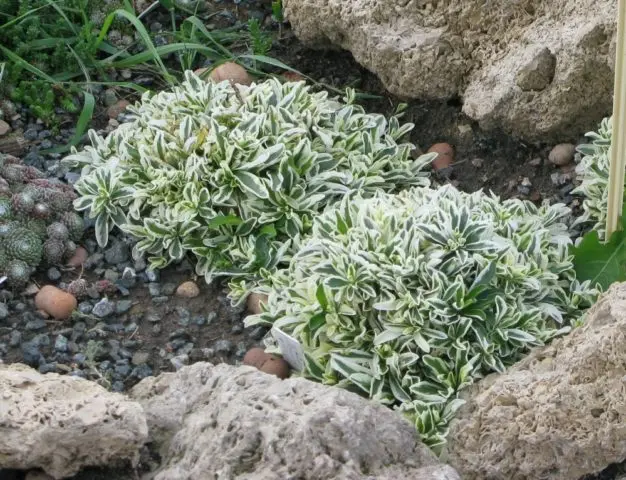
Most species of perennial arabis have white flowers.
The main parameters of the plant are indicated in the table:
Parameter | Value |
View | Perennial or annual shrub |
family | Cabbage (cruciferous) |
Stem | Generative shoots ascending, vegetative – curly or creeping branched lashes, flexible, strong, form cushion-shaped curtains |
Height of a plant | Depending on the type, from 0,1 to 0,5 m |
Leaves | Small, smooth, leathery, with a smooth edge, oval or arrow-shaped, greenish-gray, with or without felt pubescence |
Root system | Fibrous, powerful, enveloping |
Flowers | Numerous, white, yellow, pink or lilac, collected in corymbs or brushes, have a delicate sweetish aroma |
seed | Flat, ripen in pods |
Types and varieties of arabis
Certain species of perennial arabis have long been used in cultural horticulture. On their basis, many varieties have been bred that differ in color, flowering time, and size. The following are descriptions and photos of some varieties of rezuha, recommendations for planting and care.
Arabis Ferdinand of Coburg Variegata
Arabis Ferdinand Coburgii Variegata (Arabis Ferdinandi Coburgii Variegata) is a rather low, not higher than 10 cm, perennial ground cover plant. It grows rapidly, forming a continuous carpet. The stems are thin, long, easily rooted. The leaves are oval-elongated, variegated, shiny, with a green middle and a lighter border, sometimes they have lilac, purple or pink hues. Peduncles appear in May-June, their height is 10-15 cm.

Arabis perennial Ferdinand Coburg Variegata does not lose its decorative effect after flowering
The flowers are white in color, they are numerous, small, about 0,5 cm in diameter, collected in loose brushes. The main purpose is to decorate Japanese-style gardens, rockeries and alpine slides, since Arabis Ferdinand of Coburg Variegata goes well with large stones and other specialized plants.
Resnitchatolistny arabis
Perennial flower Arabis ciliated, or ciliate (Arabis blepharophylla), the photo and description of which are presented below, forms a low-growing voluminous bush-clump no more than 0,1 m high and about 0,25 m in diameter. The shoots are dense, green. The leaves are bright, greenish-gray, with dense pubescence.
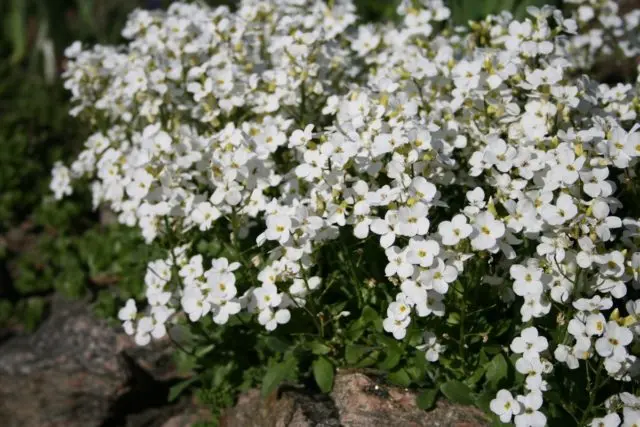
Arabis perennial ciliated blooms profusely, in May-June
Petals are painted in crimson, lilac or purple tones. Inflorescences loose, racemose.
Rose Delight
Arabis perennial ciliated Rose Delight (Rose Delight) grows up to 0,3 m. The stems are creeping, easily rooting. Flowers lilac-pink. Perennial is used as an element in the design of alpine slides and rockeries.

Arabis Rose Delight is often used to strengthen slopes.
Spring Charm
Spring Charm (Spring Charm) – one of the varieties of ciliated arabis. The bushes are small, 10-15 cm tall. The color of the flowers is lilac-pink. It can be grown in ordinary flower beds, as well as in rock gardens.

Flowers Spring Charm medium-sized, about 1 cm in diameter
Alpine
Alpine arabis (Arabis alpina) is considered one of the most popular types of rezuha. Forms a densely leafy dense curtain up to 0,35 m high. Creeping shoots, green. The leaves are small, oval-elongated, dense, pubescent, greenish with a silvery tint.
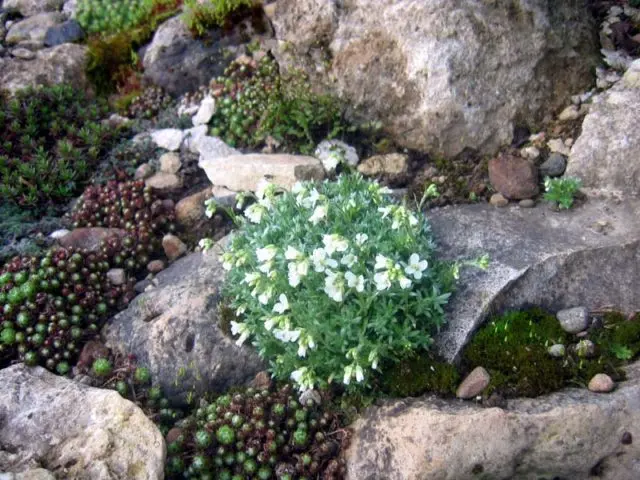
The flowering of perennial arabis alpine begins in the 2nd half of May and lasts about 2 months
During the budding period, the plant is abundantly covered with small, about 2 cm in diameter, white or pinkish flowers with a yellowish central part, collected in loose voluminous brushes.
Lapland
Arabis Laplandia (Laplandia) is one of the well-known varieties of alpine rezuha. The perennial grows rapidly, forming a continuous carpet. Flowers about 1 cm, white.
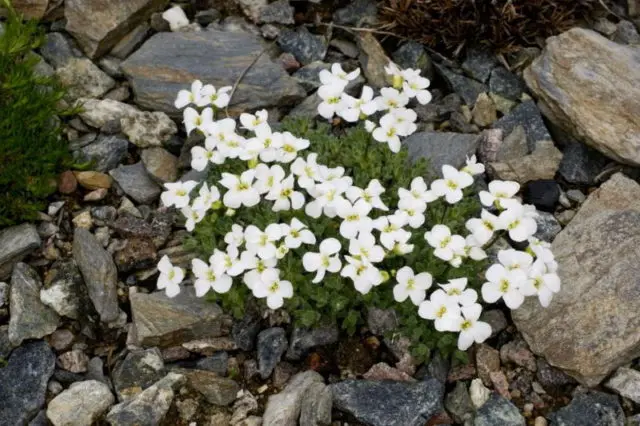
Rezuha Lapland – an excellent ground cover variety
snow carpet
Alpine arabis variety Snow carpet has white flowers. Perennial plant, used as a groundcover. The height of the bushes is 30-35 cm. Flowering time is from May to the end of June.

Rezuha Snow carpet grows rapidly over a large area
Terry
Rezuha Terry is one of the perennial varieties of Alpine arabis. Differs in double flowers of white or pink-lilac color. Inflorescences are medium-sized, corymbose type.
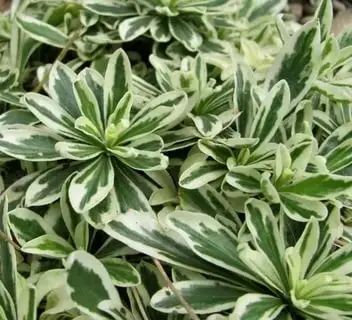
Arabis Terry begins to bloom in mid-May
Grandiflora pink
Perennial Arabis Grandiflora pink (Grandiflora rose), in comparison with other species, has rather large flowers, their diameter is about 2 cm. The height of the bush is 0,3-0,35 m. The color of the petals is pinkish-purple.
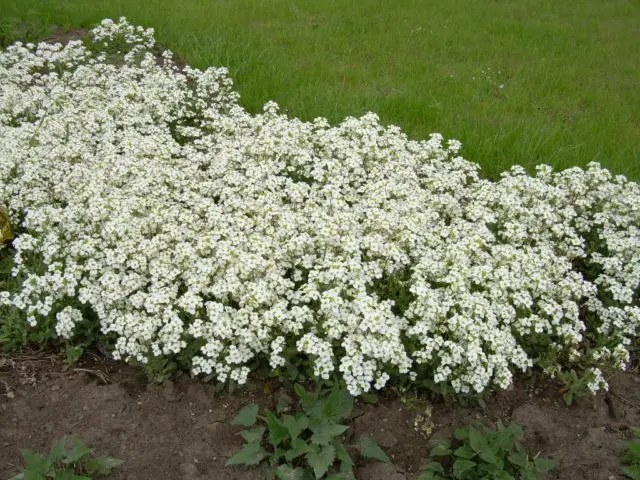
Resuhi flower Grandiflora pink is distinguished by elongated petals
Prolomnikovy
Perennial arabis prolomnikovy (Arabis androsacea) in appearance resembles a moss pad about 0,1 m high. The leaves are oval-elongated, strongly elongated, with a sharp tip, collected in whorls. Flowers appear in early summer. The corolla is open, with a small funnel. Petals are white.
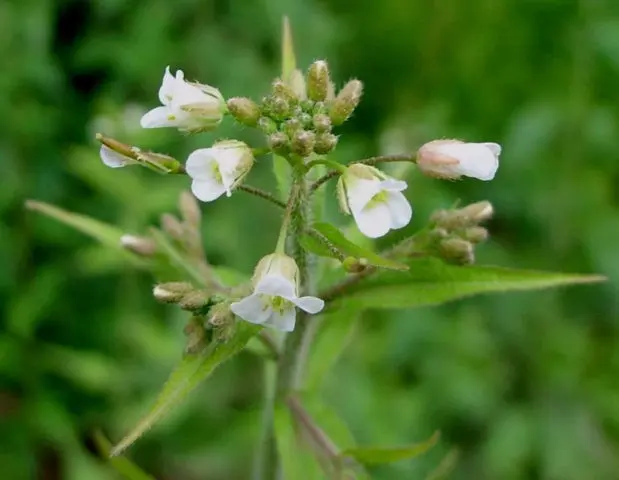
Arabis prolomnikovy – one of the most unpretentious species
In the wild, the prolomnikovy grows on the rocky slopes of the mountains, penetrating the roots into rocky cracks. In ornamental gardening, it is used in rockeries and alpine slides.
running out
Running out Arabis (Arabis procurrens) occurs naturally in many Balkan countries. It grows rapidly, forming dense clumps. It is used as a perennial ground cover plant, as well as for fixing slopes.
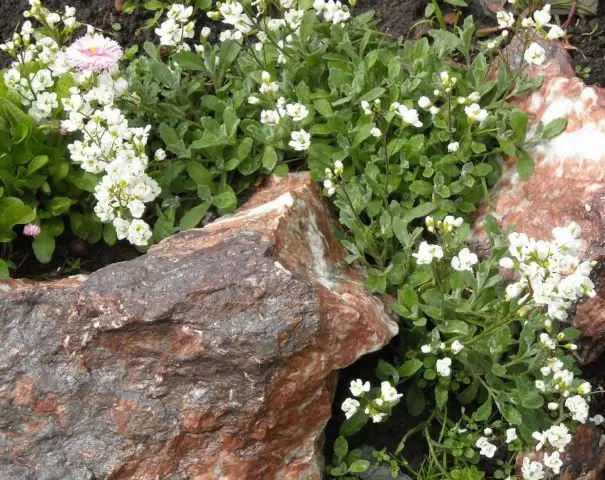
The height of the arabis bush running out does not exceed 0,15 m
Shoots strongly branched, green. The flowers are white, small. The species is characterized by increased frost resistance.
bruovidny
Perennial arabis bruovidny (Arabis bryoides) is found in the mountain ranges of the Balkans in the alpine and subalpine belts. The bush is a rosette of densely leafy stems 0,1-0,15 cm high. The leaves are small, green, elongated-ciliated, with strong felt pubescence. The inflorescence is a loose shield of small, 0,5-0,7 cm in diameter, white flowers.

Arabis bruovidny can be found in rock cracks and crevices
Grows in poor, dry, rocky soil. Used in rock gardens, rockeries.
undersized
Arabis undersized (Arabis pumila) has no decorative value and is hardly cultivated artificially. The plant is short, about 5-8 cm, rather inconspicuous. In places of natural growth (Alps and Apennine mountains) it is often found in large thickets, covering large areas.
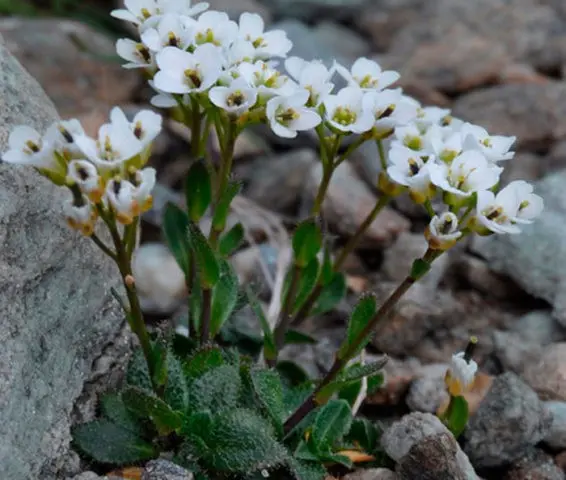
Arabis stunted can only be seen in the wild
The stems of this plant are reddish, hard. The leaves are dark green, oval-elongated, strongly pubescent, form a rosette in the lower part, from which a peduncle grows up to 15 cm high. Flowers appear in mid-spring, they are white, simple, collected in corymbs 5-8 cm in size.
Caucasian
Caucasian Arabis (Arabis caucasica) in natural conditions can be found not only in the Caucasus, but also in the Crimea, Central Asia, as well as in the mountains of many Mediterranean countries. The plant is a perennial, is a fluffy voluminous bush 0,3-0,35 cm high. It grows on stony soils, preferring open, sunny areas.

On the basis of Caucasian arabis, many cultivars have been bred
The leaves of the plant are small, heart-shaped, with a smooth or jagged edge, greenish-silvery, pubescent. Flowering begins in May and continues until the end of June. On the basis of Caucasian arabis, many varieties with different colors have been bred: white, lilac, raspberry, purple, pink. The flowers are simple or double, numerous, with a strongly pronounced aroma, collected in medium-sized brushes.
Magic carpet
Arabis Caucasian Magic Carpet is usually sold in stores as a mix. This includes plants with different colors of flowers: white, pink, lilac, purple. It is used for decorating rock gardens and rocky slopes.
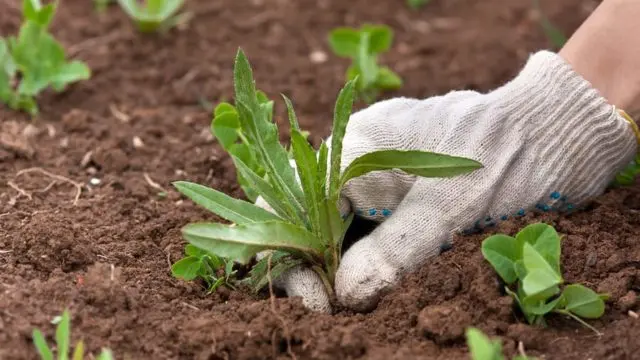
Arabis Magic Carpet is often used as a ground cover crop
Motley bedspread
A motley bedspread is a variety of Caucasian arabis with a variegated (two-color) leaf color. Thanks to this, the decorative effect of the plant is preserved even after flowering. This variegated arabis is used to decorate flower beds, create accents, decorate alpine slides and rockeries.
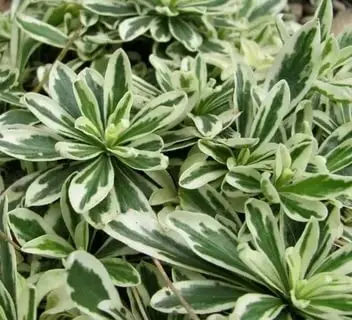
The white border on the leaves is a distinctive feature of the variety Variegated bedspread
Little Treasure Deep Rose
Arabis Caucasian Little Treasure Deep Rose (Little Treasure Deep Rose) is used mainly in flower beds and discounts. The height of the bushes does not exceed 15 cm. The flowers are small, numerous, bright pink, appear in early summer.
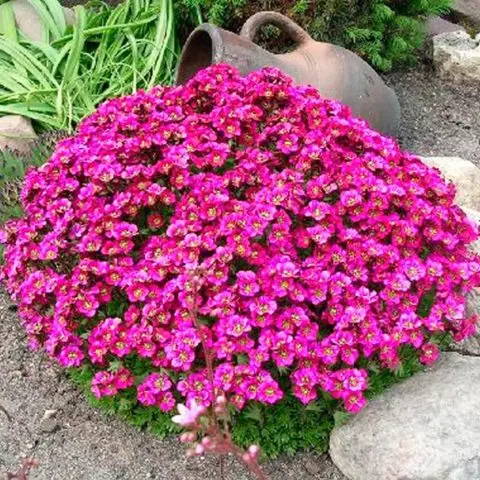
Arabis Little Treasure Deep Rose looks great in rustic landscaping
snow cloud
Arabis Snow Cloud begins to bloom in early May. The leaves are serrated, green, due to the strong pubescence have a silvery sheen. Abundant flowering, white petals.

Arabis Snow Cloud has a friendly and long flowering
Persian rug
This is a mix variety from a mixture of Caucasian arabis seeds of various colors. The bushes are low, up to 0,3 m, with creeping shoots. Flowers vary in color from white to purple.

Arabis Persian rug used as a ground cover
Rezukha Hanging
Hanging rezuha (Arabis pendula) is widespread in China, Mongolia, and the countries of Central Asia. In Our Country, it is found in the European part, as well as in Siberia and the Far East. This is an annual or biennial herbaceous plant with a rather powerful stem up to 1,2 m high. The leaves are petiolate (in the lower part), sessile above, oval-elongated, with a pointed end.
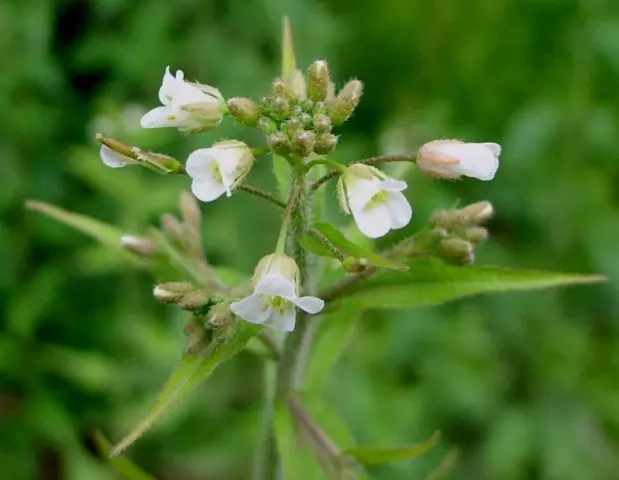
Rezuha drooping refers to rare and endangered species
Cystic inflorescences appear at the ends of the shoots in mid-summer. Sepals pubescent. The petals of small flowers are white, the corolla is simple. Seeds are small, about 2 mm, ripen in long flat pods in August-September. Rezukha hanging is listed in the Red Book of Vladimir, Ivanovo, Moscow and some other regions of Our Country.
Arabis pink
Pink arabis (Arabis rosea) is a perennial that grows in a compact bush about 0,25 m high. The stems are climbing, creeping. The leaves are elongated, small, oval, due to strong pubescence have a silvery tint.
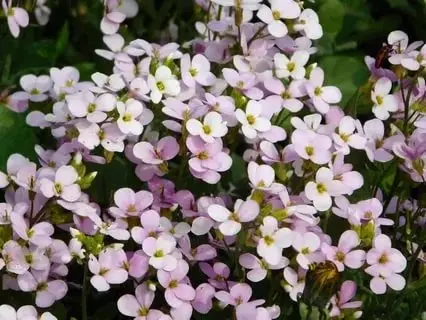
Arabis pink remains highly decorative even after flowering
Petals are pale pink in color. The flowers are large, up to 2 cm in diameter, collected in large corymbs. The view is used to decorate the rocky landscape.
Arabis in landscape design
Arabis perennial in nature very often grows in mountainous areas, preferring areas with rocky soil, cracks in the rock, rocky slopes. This fact determined its purpose in landscape design. The plant is great for decorating alpine slides and Japanese gardens, it looks great in rockeries.
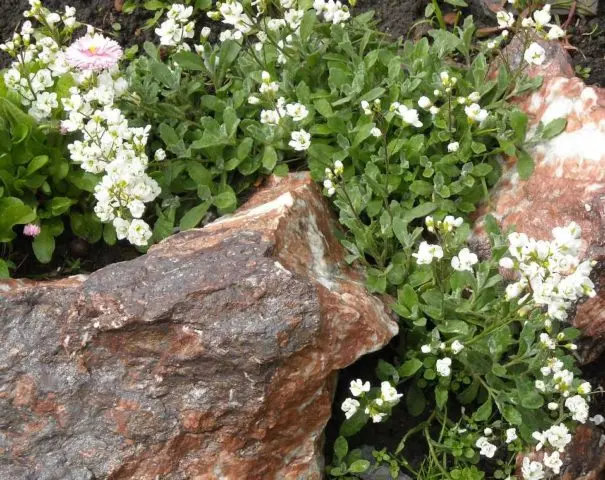
Arabis looks great in combination with rock
The ability of resuha to form dense curtains is used to create a kind of flower “pillows”. Such a composition will look great in a wide flowerpot, in the central part of a flower bed or against a stone wall.
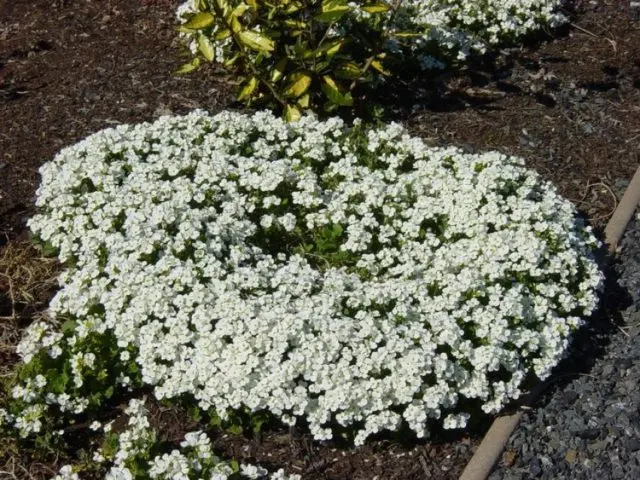
Round “cushions” are a great accent in the garden
Arabis perennial is an excellent ground cover plant. It can be used to create a living carpet as well as to hold soil on slopes. Arabis looks especially impressive, filling the space between large stones.
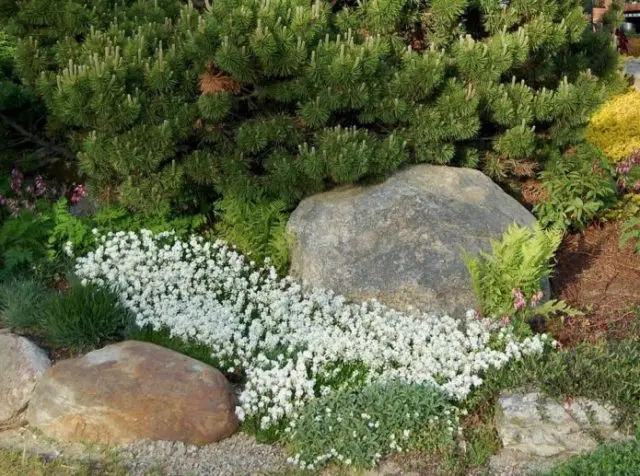
Arabis remarkably smoothes uneven terrain
The small height of the arabis makes it possible to use its individual species in multi-level beds as a background for higher flowers. Some varieties of this perennial plant are used in the design of borders, as well as to create low hedges.

Arabis will perfectly frame the edges of paths or alleys
Features of reproduction
In nature, arabis usually propagates by self-sowing. The seeds of the plant are small and very light, they can be carried by wind and water over considerable distances. For self-breeding of perennial arabis, you can use any of the following methods:
- Reproduction by seeds.
- Cuttings.
- Layers.
- By dividing the bush.
Growing arabis from seeds
You can buy perennial arabis seeds on your own in specialized stores or markets. And it’s also easy to do this via the Internet, on sites for gardeners.
When and how to plant
Arabis seeds purchased for cultivation can be planted immediately in open ground (before winter). In this case, the planting material is stratified in a natural way. Seeds are evenly embedded in the soil to a depth of no more than 0,5 cm, or simply distributed over the surface of the earth, and then sprinkled with a small layer of peat-sand mixture.
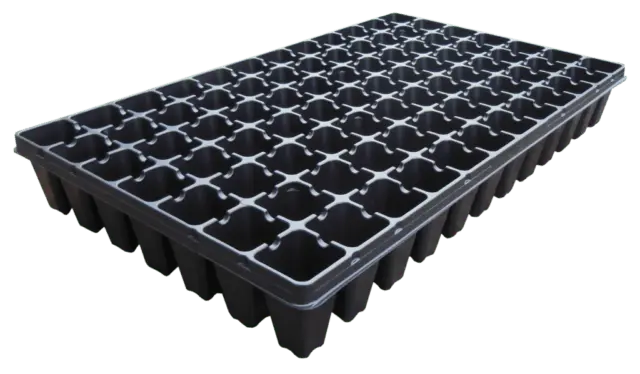
For planting seeds, it is convenient to use special cassettes for seedlings.
In spring, the seeds are pre-germinated in group or individual containers, containers or cups. They are filled with special soil for seedlings or a mixture of sand and peat (1: 1) with the addition of medium-sized pebbles. The soil is pre-moistened, then the seeds are evenly sown, sprinkling them with a thin layer of earth. The containers are covered with foil and placed in a warm shaded place.
Care of seedlings
It takes about 3 weeks for the seeds to germinate. After the appearance of the first shoots, the film from the containers must be completely removed, and the containers themselves must be transferred to a well-lit place. When the soil dries out, it should be moistened, but it must be remembered that excess water is detrimental to resuha.

Arabis seeds have good germination
After the appearance of a pair of permanent leaves, young seedlings need to dive into separate pots or cups. Transplanting seedlings into open ground is carried out only after the soil warms up well and the likelihood of return frosts has passed.
Planting perennial arabis in the ground
For long-term rezuha, it is very important to choose the right place and land on time. In this case, the plant will feel good and will please with abundant flowering.
Deadlines
Autumn planting of seeds in open ground in a permanent place is usually carried out at the end of October. This non-seedling method mimics the natural propagation conditions of perennial self-sowing arabis. Germination of seeds using this method is low. The grown seedlings are transplanted to an open place in May, when the soil temperature rises to + 8-10 ° C.
Site selection and preparation
Under natural conditions, perennial arabis grows on rocky, sometimes even rocky ground. It is very important when planting it to provide similar conditions, the soil should be well-drained and rather poor. To provide such parameters, a little sand and small stones can be added to the soil. The site should be open and have good sunlight, this will help the rezuha not stretch out and preserve the natural color of the leaves and buds. It is allowed to plant perennial seedlings in light partial shade.
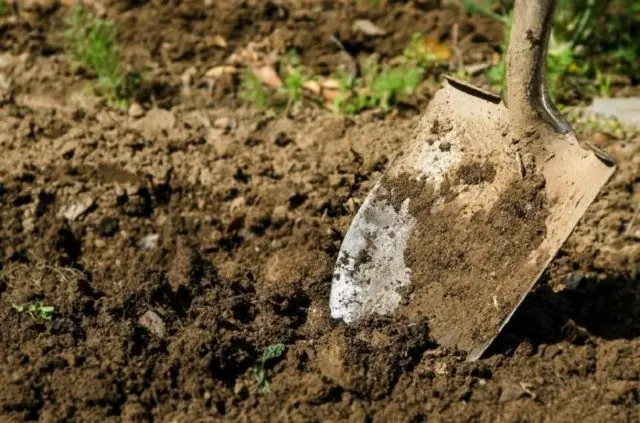
Before planting, the site must be pre-prepared
The landing site should be dug up, adding chalk, limestone or dolomite flour to the soil, since this plant prefers moderately alkaline soils. It is also necessary to remove debris and weeds so that they do not clog young seedlings, taking away some of their nutrients.
Rules of landing
Planting of seedlings of perennial cress is carried out with an interval of 0,3 m between neighboring plants. Holes should be dug in advance and spilled with water. Plants are removed from the cup along with the earth on the roots and planted vertically, after which voids are sprinkled and compacted. The procedure ends with intensive watering of the root zone.
Features of care
Arabis perennial is well adapted to adverse conditions, since many of its species grow in the mountains. However, in order to preserve and maintain the decorative appearance, certain maintenance measures will not be superfluous.
Watering and fertilizing schedule
Excessive humidity for perennial arabis is harmful, it does not tolerate stagnant water in the roots and may die. Therefore, watering is carried out only when necessary, for example, if there has been no precipitation for a long time. If the soil is loose and well drained, then it should be moistened a little more often.
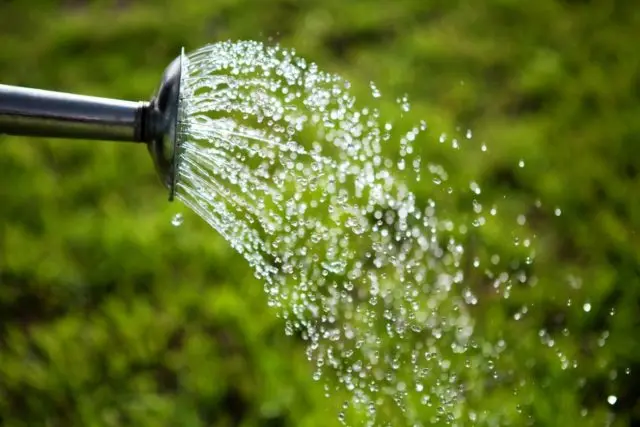
In most cases, atmospheric moisture is quite enough for rezuha.
Perennial arabis does not require rich fertile soils. The plant feels great on rocky soil, it does not need additional feeding. It is enough to add a small amount of humus or compost to the root zone in the spring.
Weeding and loosening
Caring for the root zone stimulates the rezuha to grow, and also increases the decorativeness of the plant as a whole. This is especially important at the initial stage, after planting seedlings. At this time, young perennials are very vulnerable, and weeds are able to completely suppress their growth. To prevent this from happening, the root zone must be periodically loosened and cleared of weeds.
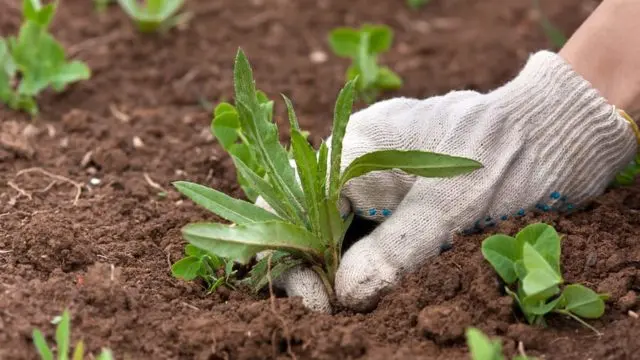
Weeds can oppress seedlings, they need to be regularly disposed of.
Mulching gives a good effect, it not only improves the air permeability of the soil, but also does not allow weeds to develop. To do this, you can use peat, the bark of coniferous trees, as well as pebbles, small pebbles, coarse sand.
Trimming
Perennial pruning is done mainly for decorative purposes. The bush is maintained in the required dimensions, pruning too long shoots, and also periodically sanitize it, removing dry and broken branches.
Preparation for winter
Perennial arabis does not belong to cold-resistant species, its winter hardiness does not exceed -5-10 ° C. Therefore, in most of the territory of Our Country, he needs mandatory shelter for the winter. At the end of autumn, the bush is cut to a height of 5-8 cm from the ground, then sprinkled with fallen leaves, and later covered with snow. Above single bushes, you can build a fabric shelter on a wooden frame in the form of a house.
Pests and diseases
Arabis perennial is almost not susceptible to diseases. Fungal infections such as root rot can result from excessive moisture. In this case, you need to take care of arranging good drainage or transplanting the plant to a drier place.
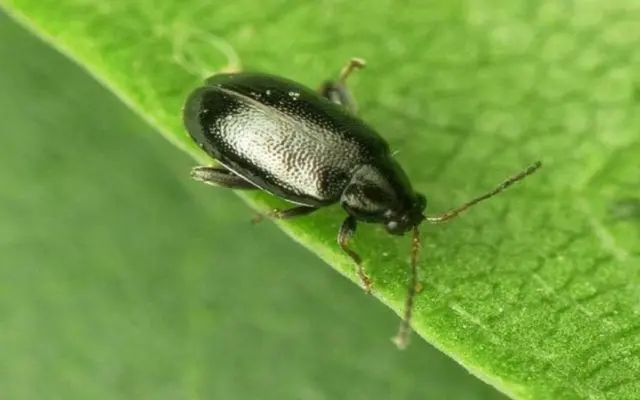
The cruciferous flea feeds on the leaves of rezuha and other plants of the Cabbage family.
Pests also do not favor arabis for many years with their attention. Occasionally on the plant you can see such typical cruciferous insects as fleas, bugs, caterpillars. Fight them by spraying with various insecticides.
Conclusion
Planting and caring for perennial arabis does not take much time. Many amateur gardeners do not carry out any activities with this plant at all, especially if it is planted somewhere in the far corner of the garden. Despite this, the perennial rhubarb will still bloom and grow, and if you provide it with at least minimal care, then it will show itself in all its glory.









